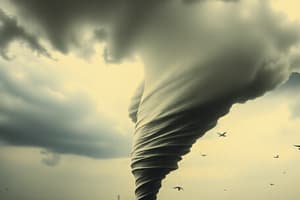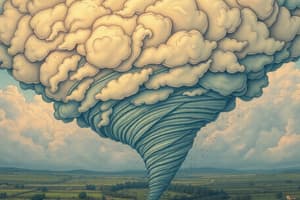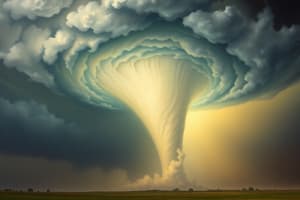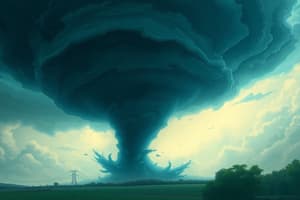Podcast
Questions and Answers
Why is it challenging for meteorologists to accurately predict tornado formation and touchdown?
Why is it challenging for meteorologists to accurately predict tornado formation and touchdown?
- The duration of a tornado's formation and ground contact is relatively short. (correct)
- Stormchasers interfere with data collection, leading to inaccurate predictions.
- Tornadoes primarily occur in areas lacking advanced radar technology.
- Computer modeling is ineffective in predicting the complex dynamics of tornado formation.
How does the destruction of forests by tornadoes contribute to ecological imbalances?
How does the destruction of forests by tornadoes contribute to ecological imbalances?
- Tornadoes enrich the soil, promoting the growth of native plant species.
- Destroyed areas recover quickly due to increased sunlight exposure.
- Tornadoes create natural firebreaks, preventing larger wildfires.
- The destruction leads to decreased biodiversity due to habitat loss. (correct)
What technological tool is most used by meteorologists to detect areas of rotation within a thunderstorm that may lead to tornado formation?
What technological tool is most used by meteorologists to detect areas of rotation within a thunderstorm that may lead to tornado formation?
- Doppler radar (correct)
- Thermometers
- Barometers
- Anemometers
What is the primary purpose of the Enhanced Fujita Scale?
What is the primary purpose of the Enhanced Fujita Scale?
According to the Enhanced Fujita Scale, what type of damage is typically associated with an EF2 tornado?
According to the Enhanced Fujita Scale, what type of damage is typically associated with an EF2 tornado?
What contributed to the development of the Enhanced Fujita Scale?
What contributed to the development of the Enhanced Fujita Scale?
How are a tornado's size and path length related to its level of destruction?
How are a tornado's size and path length related to its level of destruction?
Which combination of factors contributes MOST significantly to the high frequency of tornadoes in regions like Tornado Alley?
Which combination of factors contributes MOST significantly to the high frequency of tornadoes in regions like Tornado Alley?
A storm has vertical wind shear, and warm air is being pulled upwards into a rotating cylinder of air. What effect will this have on the rotation?
A storm has vertical wind shear, and warm air is being pulled upwards into a rotating cylinder of air. What effect will this have on the rotation?
Why is it important for a funnel cloud to connect with both the ground and the thunderstorm cloud to be classified as a tornado?
Why is it important for a funnel cloud to connect with both the ground and the thunderstorm cloud to be classified as a tornado?
How does Doppler radar technology help in providing early warnings for tornadoes?
How does Doppler radar technology help in providing early warnings for tornadoes?
A meteorologist observes a supercell thunderstorm with strong rotation but no visible funnel cloud. Why wouldn't they classify this as a tornado?
A meteorologist observes a supercell thunderstorm with strong rotation but no visible funnel cloud. Why wouldn't they classify this as a tornado?
In what way does vertical wind shear contribute to the formation of tornadoes within supercell thunderstorms?
In what way does vertical wind shear contribute to the formation of tornadoes within supercell thunderstorms?
Why are supercell thunderstorms statistically more likely to produce tornadoes compared to other types of thunderstorms?
Why are supercell thunderstorms statistically more likely to produce tornadoes compared to other types of thunderstorms?
What is the MOST accurate interpretation of the statement: "The term tornado is derived from the word tornar, which means 'to turn' in Spanish?"
What is the MOST accurate interpretation of the statement: "The term tornado is derived from the word tornar, which means 'to turn' in Spanish?"
Flashcards
Tornado
Tornado
A violently rotating column of air formed during thunderstorms.
Tornado Wind Speed
Tornado Wind Speed
Up to 250 miles per hour.
Tornado Alley
Tornado Alley
South Dakota, Nebraska, Kansas, Oklahoma, northern Texas, and eastern Colorado
Supercell
Supercell
Signup and view all the flashcards
Tornado Formation
Tornado Formation
Signup and view all the flashcards
Updraft
Updraft
Signup and view all the flashcards
Funnel Cloud
Funnel Cloud
Signup and view all the flashcards
Hook Echo
Hook Echo
Signup and view all the flashcards
Enhanced Fujita Scale
Enhanced Fujita Scale
Signup and view all the flashcards
Tornado Size and Path
Tornado Size and Path
Signup and view all the flashcards
EF0 Damage
EF0 Damage
Signup and view all the flashcards
EF1 Damage
EF1 Damage
Signup and view all the flashcards
EF2 Damage
EF2 Damage
Signup and view all the flashcards
EF3 Damage
EF3 Damage
Signup and view all the flashcards
Study Notes
- Tornadoes are violently rotating columns of air formed during thunderstorms with wind speeds up to 250 mph.
- The word "tornado" comes from the Spanish word "tornar," meaning "to turn."
- Tornadoes are also known as twisters, cyclones, or funnel clouds.
- Tornadoes most commonly occur in southern Canada and "Tornado Alley" in the United States.
- "Tornado Alley" includes South Dakota, Nebraska, Kansas, Oklahoma, northern Texas, and eastern Colorado.
- The Great Plains and Florida are prone to tornadoes due to frequent thunderstorms.
Tornado Formation
- Tornadoes usually form in late spring and summer when conditions favor supercell formation and updrafts.
- A supercell is a large thunderstorm with rotating winds, occurring in about 1 in 1000 storms.
- Supercells produce tornadoes approximately 20% of the time.
- Varying wind speeds at different altitudes during thunderstorms may lead to tornado formation.
- Vertical wind shear during supercell formation can produce a horizontally rotating air column.
- Updrafts lift the rotating air column, causing it to narrow and spin faster, forming a funnel cloud.
- A funnel cloud becomes a tornado when it touches both the ground and the source cloud.
- Doppler radar detects hook echoes, bends in radar signals, providing about 10 minutes' warning of a tornado.
Tornado Effects
- Tornadoes can be over 660 feet wide and typically travel less than six miles.
- Tornadoes cause widespread destruction and loss of life due to high wind speeds.
- Tornadoes cause approximately $400 million in damage annually in the US.
- Around 70 people die each year due to tornadoes.
- Tornadoes damage the environment by destroying forests and wildlife habitats.
- Wind-damaged forests are more susceptible to non-native plant species invasion, slowing recovery and impacting neighboring habitats.
Categorizing Tornadoes
- Meteorologists use Doppler radar and computer modeling to predict tornadic activity.
- Hook echoes identify areas of rotation within thunderstorms, aiding public warnings.
- Storm chasers use equipment and weather balloons to measure factors involved in tornado formation.
- National Weather Service scientists assess damage to determine wind speed and path, assigning a number based on the Enhanced Fujita Scale.
- The Enhanced Fujita Scale evaluates damage to buildings and trees caused by specific wind speeds.
- The Enhanced Fujita Scale uses 28 damage indicators to assign a rating.
- Tornado size and path length correlate positively with destruction levels.
- Longer path length and increased width leads to greater tornado intensity.
Enhanced Fujita Scale
- Before 2007, the Fujita-Pearson (FPP) scale was used, based on damage types rather than wind speed.
- The Enhanced Fujita (EF) Scale, introduced in 2007, incorporates damage indicators and degrees of damage to reflect wind speeds.
- The lowest EF Scale number signifies a weak tornado, with strength increasing with higher numbers.
- EF0: 65-85 mph, broken tree branches, some shingles blown off.
- EF1: 86-110 mph, loss of exterior doors, many shingles blown off.
- EF2: 111-135 mph, roofs torn off homes, mobile homes destroyed.
- EF3: 136-165 mph, severe damage to large buildings, overturned trains and cars.
- EF4: 166-199 mph, whole houses leveled.
- EF5: 200-230 mph, houses swept away.
Studying That Suits You
Use AI to generate personalized quizzes and flashcards to suit your learning preferences.





